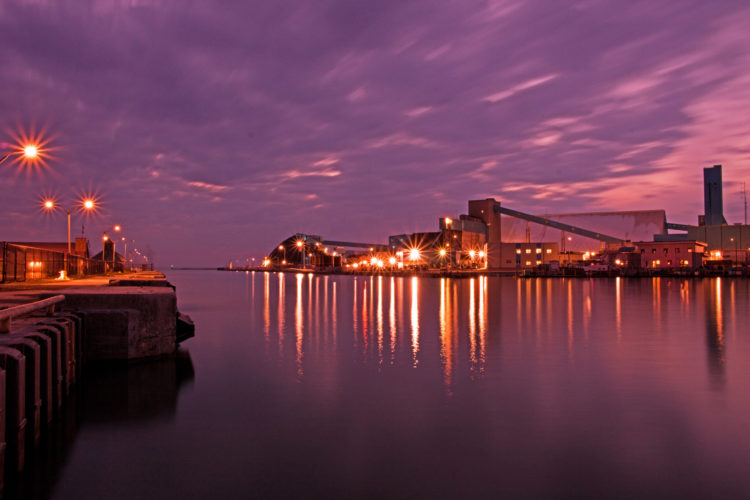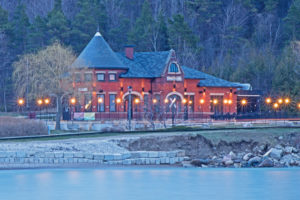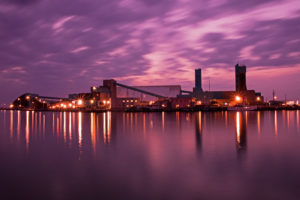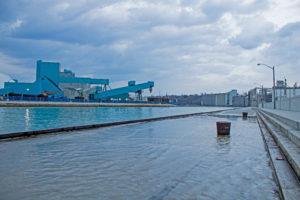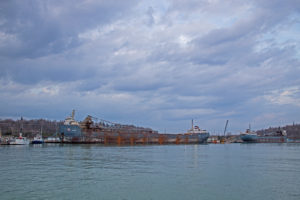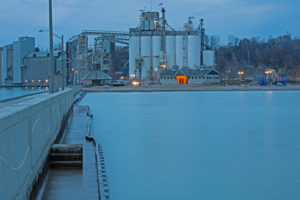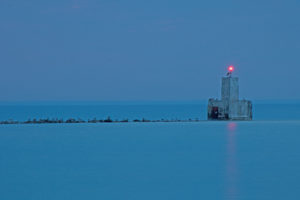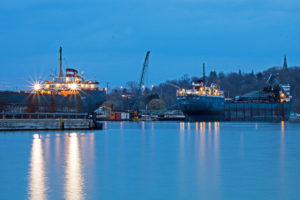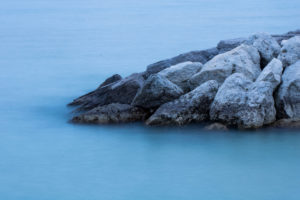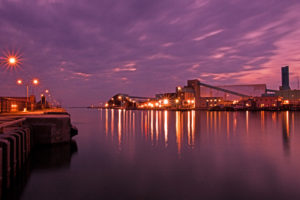 It was an iffy afternoon / evening. The sun was shining but the clouds were building and there were thunderstorms in the forecast. I had just completed a mission to drop off my brother at his house in Bayfield (he had brought over the motorhome I bought off him – more on that in an upcoming post(s)). I had hoped to hang around and catch the sunset in Bayfield but it wasn’t looking good. I head up the coast for Goderich, Ontario in hopes of some better conditions.
It was an iffy afternoon / evening. The sun was shining but the clouds were building and there were thunderstorms in the forecast. I had just completed a mission to drop off my brother at his house in Bayfield (he had brought over the motorhome I bought off him – more on that in an upcoming post(s)). I had hoped to hang around and catch the sunset in Bayfield but it wasn’t looking good. I head up the coast for Goderich, Ontario in hopes of some better conditions.
I arrived in time for a cloud blocked sunset. However, there were some photographic tweaks I really wanted to put into practice. Pros will snicker and shake their heads at the two simple things I was employing. But, for me, it was a revolution after a number of years shooting photos just plain wrong. I’m still not doing it right but I’m a now a little less wrong. Like Mark Manson said in his great book The Subtle Art of Not Giving a F*ck: A Counterintuitive Approach to Living a Good Life (Available at Amazon), “When we learn something new, we don’t go from “wrong” to “right.” Rather, we go from wrong to slightly less wrong.”
What were the tweaks? Again, I see the real photographers out there shaking their heads and smirking. First, I love evening and night photography. It provides mysterious scenes that the naked eye just doesn’t see. However, I traditionally had faith in some ‘auto’ settings on my camera. Particularly, the ISO setting. Auto settings are built to provide you with a decent image in the fastest way possible. In low light, that means jacking up the ISO to extremely high settings. That’s great, except it makes the image grainy with lots of noise.
So, I’ve started locking in the ISO at 100 for much more clarity. I still leave white balance at auto because of my second tweak. Like a broken record, I’ve heard and read it over and over again to always shoot in RAW. I’ve always ignored that advice. Until now. Shooting in this format really does open up a whole different dimension. It’s like your camera on steroids when compared to shooting JPEG. It’s nothing you notice right off, until you upload the files and process them.
Will I use it all the time? No. For the thousands of aircraft photos I take for It’s About Airplanes, it just makes sense to continue shooting in JPEG. Anyhow, in the gallery below there are a handful of images taken at Goderich Harbour on May 2, 2018. Below that is some information about the location and the ships in the harbour, along with some notes on the photos in the gallery.
Goderich, Ontario Harbour Image Gallery
For full-size, high resolution versions for any of the photos in the image gallery, simply click on the individual pictures.
Image Notes
From left to right, top to bottom.
Image 1 – Not the greatest shot but this is the historic Canadian Pacific Railway train station. Passenger service to Goderich stopped in the 1960’s and that particular line was abandoned in 1989. There is still freight service to and from the Sifto Salt Mines.
Image 2 – Looking across the Goderich Harbour at the Sifto Salt Mines. This is the largest salt mine in the world. The mineral was discovered here in 1866 and the mine is some 530 metres or 1,750 feet below the surface, spreading out quite a distance under the floor of Lake Huron.
Image 3 – Looking back up the harbour from the end of the newly reconstructed south pier. I’m not sure if the pier was built to have the water of Lake Ontario flood much of the lower portion…
Image 4 – A look at Goderich harbour with Algoma freighter ships Algoway and Algorail at dock. The ships are being filled with loads of salt. More on those boats below.
Image 5 – Looking east up the south pier at the beach area.
Image 6 – This lonely structure sits out on Lake Huron to signify the entrance to the harbour.
Image 7 – Looking west out of the harbour.
Image 8 – A low light look at Algoway and Algorail.
Image 9 – Long exposure of the break water rocks at the end of the south pier.
Goderich, Ontario
Goderich, Ontario was founded in 1827 by William ‘Tiger’ Dunlop. It was then incorporated as a town in 1850, name for Frederick John Robinson, 1st Viscount Goderich and former Prime Minister of England. the town now has a population of around 7,500.
The town is part of Huron County and is located at the mouth of the Maitland River on the eastern shores of Lake Huron. Tourism plays a bigger and bigger role in the economy of Goderich by the harbour still rules the roost. Goderich harbour takes in 250 freighter ships each year, primarily loading with salt from the Sifto mines.
If you’re looking to do some camping in the area, you should give Falls Reserve Conservation Area a try. This campground is located about ten kilometres from Goderich, along the Maitland River. The name comes from a short waterfall that provides great swimming and fishing opportunites. We have featured the park previously. Check it out here: Falls Reserve Conservation Area.
Algoma Ships
The two ships seen the image gallery are the Algoway (to the left) and the Algorail (deeper into the harbour). Both belong to Algoma Central and both were built at the Collingwood Shipyards in Collingwood, Ontario. The shipyards closed in 1986 after over a century of service.
Algorail was launched in 1967 and is 195 metres or 640 feet in length. In comparison, the Ruby Princess, an average sized luxury cruise ship, is 290 metres or 950 feet in length. On October 6, 1972, Algorail collided with a pier at Holland, Michigan, causing the ship to sink. Obviously, repairs were done and the boat was put back into service. It ran aground at Green Bay, Wisconsin on April 20, 1999 and again in the Saginaw River in Michigan on June 25, 2013.
Algoway was launched in 1972, five years after its Goderich harbour neighbour. A little bit longer than the Algorail, the Algoway is 650 feet in length.
